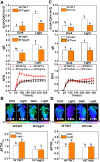Light-induced HY5 Functions as a Systemic Signal to Coordinate the Photoprotective Response to Light Fluctuation
- PMID: 32665333
- PMCID: PMC7536661
- DOI: 10.1104/pp.20.00294
Light-induced HY5 Functions as a Systemic Signal to Coordinate the Photoprotective Response to Light Fluctuation
Abstract
Optimizing the photoprotection of different leaves as a whole is important for plants to adapt to fluctuations in ambient light conditions. However, the molecular basis of this leaf-to-leaf communication is poorly understood. Here, we used a range of techniques, including grafting, chlorophyll fluorescence, revers transcription quantitative PCR, immunoblotting, chromatin immunoprecipitation, and electrophoretic mobility shift assays, to explore the complexities of leaf-to-leaf light signal transmission and activation of the photoprotective response to light fluctuation in tomato (Solanum lycopersicum). We established that light perception in the top leaves attenuated the photoinhibition of both PSII and PSI by triggering photoprotection pathways in the bottom leaves. Local light promoted the accumulation and movement of LONG HYPOCOTYL5 from the sunlit local leaves to the systemic leaves, priming the photoprotective response of the latter to light fluctuation. By directly activating the transcription of PROTON GRADIENT REGULATION5 and VIOLAXANTHIN DE-EPOXIDASE, LONG HYPOCOTYL5 induced cyclic electron flow, the xanthophyll cycle, and energy-dependent quenching. Our findings reveal a systemic signaling pathway and provide insight into an elaborate regulatory network, demonstrating a pre-emptive advantage in terms of the activation of photoprotection and, hence, the ability to survive in a fluctuating light environment.
© 2020 American Society of Plant Biologists. All Rights Reserved.
Figures









Comment in
-
A High-Five for High Light Protection.Plant Physiol. 2020 Oct;184(2):570-571. doi: 10.1104/pp.20.01212. Plant Physiol. 2020. PMID: 33020326 Free PMC article. No abstract available.
References
-
- Ahn TK, Avenson TJ, Ballottari M, Cheng Y-C, Niyogi KK, Bassi R, Fleming GR(2008) Architecture of a charge-transfer state regulating light harvesting in a plant antenna protein. Science 320: 794–797 - PubMed
-
- Baker NR.(2008) Chlorophyll fluorescence: A probe of photosynthesis in vivo. Annu Rev Plant Biol 59: 89–113 - PubMed
-
- Bratt CE, Arvidsson P-O, Carlsson M, Åkerlund H-E(1995) Regulation of violaxanthin de-epoxidase activity by pH and ascorbate concentration. Photosynth Res 45: 169–175 - PubMed
Publication types
MeSH terms
Substances
LinkOut - more resources
Full Text Sources

